| This article includes a list of general references, but it lacks sufficient corresponding inline citations. Please help to improve this article by introducing more precise citations. (July 2011) (Learn how and when to remove this message) |
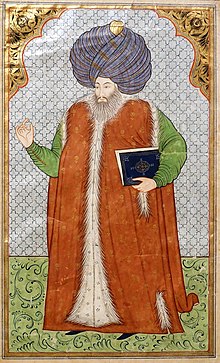
Ottoman clothing or Ottoman fashion is the style and design of clothing worn during the Ottoman Empire.
Ottoman period



While those of the palace and court dressed lavishly, common people were only concerned with covering themselves. Starting in the reign of Suleiman the Magnificent, administrators enacted sumptuary laws about the clothing of Muslims, Christians, Jewish communities, clergy, tradesmen, and state and military officials, particularly strictly enforced during the reign of Suleiman the Magnificent.
In this period men wore outer clothing like the 'mintan' (a vest or short jacket), 'zıbın', 'şalvar' (trousers), 'kuşak' (sash), 'potur', entari or kaftan (long robe), 'kalpak', 'sarık' on the head, and 'çarık', çizme (boots), 'çedik', or 'Yemeni' on the feet. The administrators and the wealthy wore caftans with fur lining and embroidery, whereas the middle class wore 'cübbe' (mid-length robe) or 'hırka' (a short robe or tunic). The poor wore collarless 'cepken' or 'yelek' (vest).
Women's everyday wear was şalvar (trousers), a gömlek(chemise) that came down to mid-calf or ankle, a short, fitted jacket called a zıbın, and a sash or belt tied at or just below the waist. For formal occasions, such as visiting friends, the woman added an entari or kaftan, a long robe that was cut like the zıbın apart from the length. Both zıbın and kaftan were buttoned to the waist, leaving the skirts open in front. Both garments also had buttons all the way to the throat but were often buttoned only to the underside of the bust, leaving the garments to gape open over the bust. All of these clothes could be brightly colored and patterned. However, when a woman left the house, she covered her clothes with a ferace, a dark, modestly cut robe that buttoned all the way to the throat. She also covered her hair and face with a pair of veils.
Headgear was the most potent indicator of male social status. While commoners wore "külahs" covered with 'abani' or 'Yemeni', higher-ranking men wore a wide variety of turbans.
Political crises of the 17th century were reflected in chaos in clothes. The excessively luxurious compulsion for consumption and showing off in the Tulip Era lasted until the 19th century. The modernization attempts of Mahmud II in the 1830s first had their effects in the state sector. While the 'sarık' was replaced by the 'fez', people employed at the Sublime Porte began to wear trousers, 'setre' and 'potin'.
Headwear
Ottoman headdresses indicated the status and occupation of the wearer. Royal turbans could be decorated with feathers in an ornamental aigrette. Starting from the 19th century, sultans started wearing fezzes instead of turbans. The daughters of sultans would receive luxurious jewelry when marrying, including diadems or veils with jewels embedded in them. Imperial and noble ladies would also cover their heads with small handkerchiefs and their faces with Brussels net veils.
There are not many records of women's clothing at the time, but artwork can provide some understanding. Headdresses were typically tall, pointed hats with a veil attached to them, which served to cover their faces during outings. In depictions of sultanas, their clothing is mostly fabricated with few references to what Ottoman women actually wore. A portrait of Roxelana depicts her wearing a pillbox-shaped headdress with decorative jewels on the border. While her headdress illustrates popular styles in Ottoman women's headwear at the time, her clothing remains very similar to European-style clothing. This was a popular way to depict women, specifically sultanas.
Many factors contributed to changes in Ottoman women's garments, including the cost of materials and firmans, or royal declarations. At the beginning of the 18th century, upper-class women began wearing yashmaks, or veils that covered their faces when going out. Over time, the yashmaks became more transparent and wider, with silver embroidery. As more changes were made to women's clothing, yashmaks and feraces were seen less as garments to cover the body, and more as decorative and ornamental styles.
In the 19th century, there were more extreme changes in women's clothing. Yemenis, or headscarves, were so thin that their hair was almost all visible. Other traditional garments combined Turkish and European fashions.
Around World War I, Turkish women began wearing headscarves tied below the chin instead of the carsaf, a robe-like dress that covered the whole body and head except for the eyes.
Tanzimat period
Main article: TanzimatDuring the 'Tanzimat' and 'Meşrutiyet' period in the 19th century, common people still wearing traditional clothing presented a great contrast with to administrators and the wealthy wearing 'redingot', jacket, waistcoat, boyunbağı (tie), 'mintan', sharp-pointed and high-heeled shoes. Women's clothes of the Ottoman period in the 'mansions' and Palace courts included 'Entari', 'kuşak', 'şalvar', 'başörtü', and the 'ferace' of the 19th century without much change.
In the 16th century, women wore two-layer long 'entari' and 'tül', velvet shawls, on their heads. Their outdoor clothing consisted of 'ferace' and 'yeldirme'. The simplification in the 17th century was apparent in an inner 'entari' worn under a short-sleeved, caftan-shaped outfit and a matching belt.
Women's wear becoming more showy and extravagant accompanied adorned hair buns and tailoring. Tailoring in its real sense began in this period. The sense of women's wear primarily began in large residential centers such as Istanbul and İzmir in the 19th century and women gradually began to participate in social life, along with the Westernization movement. Pera became the center of fashion and Paris fashions were followed by tailors of Greek and Armenian origin. In the period of Abdul Hamid II, the 'ferace' (a concealing outer robe shaped like a modestly cut version of the indoor dress) was replaced by 'çarşaf' of different styles. However, the rural sector continued to wear traditional clothing.
-
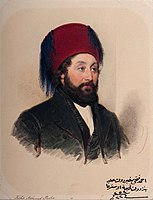 Ambassador Ahmed Fethi Pasha in Western clothing, 1835
Ambassador Ahmed Fethi Pasha in Western clothing, 1835
-
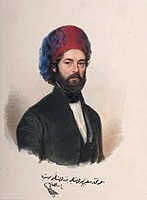 Diplomat Ahmed Muhtar Bey in Western clothing, 1844
Diplomat Ahmed Muhtar Bey in Western clothing, 1844
-
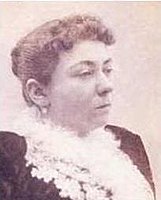 Fatma Aliye Topuz was one of the first women's rights activists, appearing in Western clothing throughout her public life
Fatma Aliye Topuz was one of the first women's rights activists, appearing in Western clothing throughout her public life
-
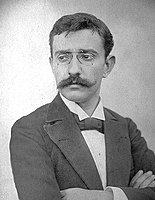 Western dress was adopted by administrators and the wealthy during the Tanzimat period (The person being depicted is Salih Zeki Bey.)
Western dress was adopted by administrators and the wealthy during the Tanzimat period (The person being depicted is Salih Zeki Bey.)
Ottoman influence on Western female dress
Further information: Turquerie and Orientalism in early modern France

Interactions between Ottomans and Britons occurred throughout history, but in the 18th century, European visitors and residents in the Ottoman Empire markedly increased, and exploded in the 19th century. As such, fashion is one method to gauge the increased interactions. Historically, Europeans clothing was more delineated between male and female dress. Hose and trousers were reserved for men, and skirts were for women. Conversely, in the Ottoman Empire, male and female dress was more similar. A common item worn by both was the şalvar, a voluminous undergarment in white fabric shaped like what is today called "harem pants". To British women traveling in the Ottoman Empire, the şalvar quickly became a symbol of freedom because they observed that Ottoman women had more rights than British women. Lady Mary Wortley Montagu (1689–1762), wife of the British ambassador to Constantinople, noted in her Turkish Embassy Letters that Ottoman women "possessed legal property rights and protections that far surpassed the rights of Western women". These female travelers often gained an intimate view of Ottoman culture, since as women, they had easier access to the Muslim elite harems than did men. Şalvar successfully spread into Europe at the end of the 19th century as various female suffragists and feminists used şalvar as a symbol of emancipation. Other British women of distinction, such as Lady Janey Archibald Campbell (1845–1923), and Lady Ottoline (Violet Anne) Morrell (1873–1938) wore şalvar "in an attempt to symbolize their refusal of traditional British standards and sexual differences". Şalvar also spread beyond Europe when Amelia Jenks Bloomer modified these "Turkish trousers" to create American "bloomers".
Another area where the Ottomans influenced female Western dress was in layering. Initially, layering had a practical use for the ancestors of the Ottoman Empire, who were pastoral nomads and horse riders, and needed to wear layers to adapt to changing temperatures. As the Ottoman Empire came into being, the layering of garments would distinguish one's gender, class, or rank within particular communities, while also displaying many sumptuous fabrics, thus signaling one's wealth and status. Layering also had spiritual significance. In Islamic art, layering different patterns represents a spiritual metaphor of the divine order that seems to be incomprehensible, but is actually planned and meaningful.
In Europe, in the 16th century, skirts began to have a layered appearance. Previous to the 16th century, skirts were slit only at the bottom, but now, the slit bisected the front of the skirt to reveal a contrasting layer underneath. Often, the underlayer would coordinate with a layered sleeve. Hanging sleeves were also a European concept derived from the Ottomans, although they arrived in Europe much earlier than layered skirts. In the 12th century, religious and scholarly peoples would wear coats that had hanging sleeves, similar to Turkish-style outer kaftans. These hanging sleeves meant one could see the second layer of fabric underneath the outer layer. Although hanging sleeves had been present in Europe since the 12th century, they did not escape Lady Mary Montague's fascination in the 18th century. In a letter dated 10 March 1717, she wrote to the Countess of Marabout Hafiz (Hafsa) Sultan, a woman who was a favorite of the deposed Sultan Mustafa: "But her dress was something so surprisingly rich, that I cannot forbear describing it to you. She wore a vest called donalmá, which differs from a caftan by long sleeves and folding over the bottom. It was of purple cloth, straight to her shape, and thick-set on each side, down to her feet, and round the sleeves, with pearls of the best water, of the same size as their buttons commonly are."
Republican period
The common clothing styles prevailing in the mid 19th century imposed by religious reasons entered a transformation phase in the Republican period. In this period the 'şapka' and the following 'kılık kıyafet' reform being realized with the leadership of Mustafa Kemal Atatürk in Kastamonu in 1925 had a full impact in Istanbul. Women's 'çarşaf' and 'peçe' were replaced by a coat, scarf, and shawl. Men began to wear hats, jackets, shirts, waistcoats, ties, trousers and shoes. With the industrialization process of the 1960s, women entered the work-life and tailors were substituted by readymade clothes industry. The contemporary fashion concept, as it is in the whole world, is apparent in both social and economic dimensions in Turkey as well.
Modern use
Modern Turkish designers such as Rıfat Özbek, Cemil İpekçi, Vural Gökçaylı, Yıldırım Mayruk, Sadık Kızılağaç, Hakan Elyaban, and Bahar Korçan draw inspiration from historical Ottoman designs, and Ottoman or Ottoman-inspired patterns are important to the Turkish textile industry.
Gallery
Religious garb (1878)
-
 Jewish rabbi
Jewish rabbi
-
 Armenian Orthodox patriarch
Armenian Orthodox patriarch
-
 Greek Orthodox priest
Greek Orthodox priest
-
 Turkish Muslim alim
Turkish Muslim alim
-
 Mendicant dervish
Mendicant dervish
-
 Active dervish
Active dervish
Everyday people (1878)
-
 Turkish peasant
Turkish peasant
-
 Turkish Zeybek
Turkish Zeybek
-
 Turkish man
Turkish man
-
 Turkish woman at home
Turkish woman at home
-
 Veiled Turkish woman
Veiled Turkish woman
-
 Porter
Porter
-
 Turkish boy
Turkish boy
-
 Turkish boy
Turkish boy
-
 Turkish girl
Turkish girl
-
 Gypsy girl
Gypsy girl
-
 Men aboard a ferry
Men aboard a ferry
-
 Men aboard a ferry
Men aboard a ferry
-
 Odalisque
Odalisque
-
 Woman outdoors
Woman outdoors
Folk costumes in 1873
-
 1. Burgher from Constantinople
1. Burgher from Constantinople
2. Aiwas (servant) -
 1. Caikji (boatman)
1. Caikji (boatman)
2. Sakka (water carrier)
3. Hammal (porter) -
 1. Mevlevi Dervish
1. Mevlevi Dervish
2. Bektashi Dervish
3. Mullah -
 1 and 2. Turkish ladies from Constantinople
1 and 2. Turkish ladies from Constantinople
3. Turkish schoolboy -
 1. Armenian bride
1. Armenian bride
2. Jewish woman from Constantinople
3. Greek girl
-
 1. Muslim inhabitant of Edirne
1. Muslim inhabitant of Edirne
2. Muslim horseman from Edirne
3. Christian artisan from Edirne -
 1. Macedonian peasant from Monastir
1. Macedonian peasant from Monastir
2. Macedonian peasant woman Monastir
3. Bulgarian woman from Shkodër -
 1. Muslim horseman from Plovdiv
1. Muslim horseman from Plovdiv
2. Bulgarian man from Koyountepe
3. Bulgarian man from Ah'i Tchelebi -
 1. Bulgarian woman from Ahi Tchelebi
1. Bulgarian woman from Ahi Tchelebi
2. Greek woman from Haskovo
3. Peasant woman from Baidjas
-
 1: Bulgarian man from Sofia
1: Bulgarian man from Sofia
2. Bulgarian woman from Sofia -
 1: Bulgarian woman from Ruse
1: Bulgarian woman from Ruse
2. Christian Bulgarian from Vidin
3. Muslim Bulgarian from Vidin
- Vilayet of Prizren; Vilayet of Scutari
-
 1: Muslim woman from Prizren
1: Muslim woman from Prizren
2. Farmers from around Prizren
3. Christian peasant woman from Matefse -
 1: Hodja from Shkodër
1: Hodja from Shkodër
2. Christian priest from Shkodër -
 1: Muslim lady from Shkodër
1: Muslim lady from Shkodër
2. Christian lady from Shkodër
3. Peasant woman from Malissor -
 1: Muslim from Shkodër
1: Muslim from Shkodër
2. Muslim lady from Shkodër -
 1: Christian from Shkodër
1: Christian from Shkodër
2. Christian lady from Shkodër -
 1: Shepherd and peasant woman from Malissor
1: Shepherd and peasant woman from Malissor
-
 1: Wealthy Arnaut from Ioannina
1: Wealthy Arnaut from Ioannina
2. Wealthy Arnaut lady from Ioannina
3. Arnaut child of a wealthy family. -
 1: Arnaut from Ioannina (middle class)
1: Arnaut from Ioannina (middle class)
2. Arnaut from Ioannina (lower class) -
 1: Wallachian (Aromanian) Woman from Ioannina
1: Wallachian (Aromanian) Woman from Ioannina
2. Christian woman from Preveza
3. Peasant woman from around Trikala -
 1: Hodja from Saloniki
1: Hodja from Saloniki
2. Hakham Bashi of Saloniki
3. Burgher from Monastir -
 1: Muslim lady from Saloniki
1: Muslim lady from Saloniki
2. Jewish lady from Saloniki
3. Macedonian woman from Prilep -
 1: Inhabitant of Mostar
1: Inhabitant of Mostar
2. Burgher from Sarajevo
3. Lady from Sarajevo
-
 1. Christian burgher from Chania
1. Christian burgher from Chania
2. Christian horseman from Chania
3. Muslim lady from Chania -
 1. Female Christian villager from Chania
1. Female Christian villager from Chania
2. Christian villager from Chania
3. Inhabitant of Sfakia
-
 1. Muslim Artisan man and woman from Çanakkale
1. Muslim Artisan man and woman from Çanakkale
-
 1. Yorouk (nomad) from Biga
1. Yorouk (nomad) from Biga
2. Christian inhabitant of Chios
3. Christian from Lemnos -
 1. Yorouk woman from Biga
1. Yorouk woman from Biga
2. Christian woman from Chios
3. Christian woman from Lemnos -
 1. Muslim from Rhodes
1. Muslim from Rhodes
2. Muslim lady from Rhodes -
 1. Jew from Rhodes
1. Jew from Rhodes
2. Jewish woman from Rhodes -
 1. Christian inhabitant of Lesbos
1. Christian inhabitant of Lesbos
2. Christian woman from Lesbos
3. Christian woman from Symi -
 1. Christian inhabitant of Famagusta
1. Christian inhabitant of Famagusta
2. Christian woman from Famagusta
3. Greek religious man of the Tchiko Monastery, near Lefka
-
 1. Turkmen from around Bursa
1. Turkmen from around Bursa
-
 1. Peasant man and woman from around Bursa (wearing wedding clothing)
1. Peasant man and woman from around Bursa (wearing wedding clothing)
2. Seis (horse groom) -
 1. Jew and Jewish woman from Bursa
1. Jew and Jewish woman from Bursa
-
 1. Zeibek
1. Zeibek
2. Artisan from Aydın -
 1. Christian merchant from Aydın
1. Christian merchant from Aydın
2. Haham from İzmir
3. Burgher from Manisa -
 1. Muslim lady from Manisa
1. Muslim lady from Manisa
2. Muslim lady from İzmir
-
 1. Christian from Konya
1. Christian from Konya
2. Muslim horseman from Konya
3. Inhabitant of Elmalı -
 1. Armenian Priest from Konya
1. Armenian Priest from Konya
2. Mullah from Konya
3. Greek Priest from Konya -
 1. Burgher from Konya
1. Burgher from Konya
2. Greek woman from Burdur
3. Muslim woman from Burdur -
 1. Armenian woman from Burdur
1. Armenian woman from Burdur
2. Turkmen woman from Karie de Outmouk
3. Kurdish woman from Sarıkaya
-
 1. Muslim Artisan from Ankara
1. Muslim Artisan from Ankara
2. Christian Artisan from Ankara
3. Kurd from around Yozgat -
 1. Bashi-bazouk from Ankara
1. Bashi-bazouk from Ankara
2. Muslim peasant from around Ankara
3. Muslim peasant woman from around Ankara -
 1. Kurdish woman from around Yozgat
1. Kurdish woman from around Yozgat
2. Female Christian artisan from Ankara
3. Muslim female artisan from Ankara
-
 1. Turkish worker from Kastamonu
1. Turkish worker from Kastamonu
2. Peasant from Safranbolu
3. Kurd from Viranşehir
-
 1. Turkish woman from Osmancık
1. Turkish woman from Osmancık
2. Muslim artisan from Amasya
3. Christian lady from Tokat -
 1. Muslim woman from Sivas
1. Muslim woman from Sivas
2. Armenian woman from Sivas
3. Kurdish woman from around Sivas
-
 1. Muslim from Trabzon
1. Muslim from Trabzon
2. Muslim peasant woman from around Trabzon
3. Laz man -
 1. Muslim lady from Trabzon (indoor dress)
1. Muslim lady from Trabzon (indoor dress)
2. Muslim lady from Trabzon (outdoor dress)
-
 1. Worker from around Erzurum
1. Worker from around Erzurum
2. Muslim woman from Van
3. Armenian woman from Van -
 1. Armenian priest from Akhtamar
1. Armenian priest from Akhtamar
2. Kurdish horseman from Hakkâri
3. Kurdish piade (foot soldier) from Hakkâri
-
 1. Muslim from Diyarbakır
1. Muslim from Diyarbakır
2. Christian from Diyarbakır
3. Kurd from Palu -
 1. Muslim lady from Diyarbakır.
1. Muslim lady from Diyarbakır.
2. Christian lady from Diyarbakır
3. Kurdish woman from Palu -
 1. Shepherd from around Diyarbakır
1. Shepherd from around Diyarbakır
2. A Kurd from Cizre
3. Kurd from around Mardin -
 1. Muslim lady from Sa'nt (indoor clothing)
1. Muslim lady from Sa'nt (indoor clothing)
2. Muslim lady from Sa'nt (outdoor clothing)
3. Kurdish woman from Elazığ
-
 1. Bedouin from the vilayet of Aleppo
1. Bedouin from the vilayet of Aleppo
2. Bedouin woman from the vilayet of Aleppo
3. Jewish lady from Aleppo -
 1. Muslim from around Adana
1. Muslim from around Adana
2. Muslim woman from around Tarsus
3. Inhabitant of Hadjin
-
 1. Christian inhabitant of Beirut (summer dress)
1. Christian inhabitant of Beirut (summer dress)
2. Muslim lady from Beirut
3. Christian lady from Beirut (winter dress) -
 1. Muslim from Lebanon
1. Muslim from Lebanon
2. Muslim woman from Lebanon -
 1. Christian mountain dweller, from Zahlé (Lebanon)
1. Christian mountain dweller, from Zahlé (Lebanon)
2. Christian mountain dweller, from Zgharta (Lebanon)
3. Druze from Lebanon -
 1. Christian woman from Zahlé (Lebanon)
1. Christian woman from Zahlé (Lebanon)
2. Christian woman from Zgharta (Lebanon)
3. Druze woman from Lebanon -
 1. Bedouin from Mount Lebanon.
1. Bedouin from Mount Lebanon.
2. Bedouin woman from Lebanon -
 1. Fellah from around Damascus
1. Fellah from around Damascus
2. Druze from around Damascus
3. Arab nomad woman from the Ourban tribe -
 1. Fellah woman from around Damascus
1. Fellah woman from around Damascus
2. Druze woman from around Damascus
3. Lady from Damascus -
 1. Christian artisan from Belka
1. Christian artisan from Belka
2. Artisan woman from Belka
3. Peasant Muslim woman from around Belka -
 1. Shopkeeper from Belka
1. Shopkeeper from Belka
2. Fellah from around Belka
3. Muslim artisan from Belka -
 1. Jew from Jerusalem
1. Jew from Jerusalem
2. Jewish woman from Jerusalem -
 1. Arab lady from Jerusalem
1. Arab lady from Jerusalem
2. Fellah from around Jerusalem
3. Fellah woman from around Jerusalem
- Vilayets of Baghdad; Hejaz; Yemen; Tripolitania
-
 1. Arab man of the Shammar tribe
1. Arab man of the Shammar tribe
2. Arab man from Zubaid tribe
3. Muslim lady from Baghdad -
 1. A'alim from Mecca
1. A'alim from Mecca
2. Inhabitant from Djeaddele (environs of Mecca)
3. Baveri of the guard of the Sharif of Mecca -
 1. Kabyle of the Harb tribe (environs of Medina)
1. Kabyle of the Harb tribe (environs of Medina)
2. Kabyle woman of the Harb tribe (environs of Medina)
3. Muslim woman from Djeaddele (environs of Mecca) -
 1. A'alim from Al Hudaydah
1. A'alim from Al Hudaydah
2. Burgher from Al Hudaydah
3. Muslim lady from Sana'a -
 1. Shopkeeper from Mocha
1. Shopkeeper from Mocha
2. Muslim lady from Mecca
3. Moorish girl from Tripoli
See also
- Kaftan
- Calpack
- Fez
- Jelick
- Turkish salvar
- Harem pants
- Bloomers
- Turban
- Yashmak
- Dolman
- Çarşaf
- Delia (clothing)
- Kontusz
- Pas kontuszowy
- Żupan
- Towel
- Timeline of the Turks (500–1300)
Notes
- İrepoğlu, Gül (2012). Imperial Ottoman jewellery: reading history through jewellery. Feyza Howell. İstanbul. ISBN 978-605-5488-14-7. OCLC 815521945.
{{cite book}}: CS1 maint: location missing publisher (link) - Madar, Heather (2011). "Before the Odalisque: Renaissance Representations of Elite Ottoman Women". Early Modern Women. 6: 1–41. doi:10.1086/EMW23617325. ISSN 1933-0065. JSTOR 23617325. S2CID 164805076.
- Koç, Fatma; Koca, Emine (January 2007). "The Westernization Process in Ottoman Women's Garments: 18th Century~20th Century". Asian Journal of Women's Studies. 13 (4): 57–84. doi:10.1080/12259276.2007.11666035. ISSN 1225-9276. S2CID 155237364.
- Charlotte Jirousek. Ottoman Costumes: From Textile to Identity. S Faroqhi and C. Neumann, ed. Istanbul: Eren Publishing, 2005.
- Inal, Onur. "Women's Fashions in Transition: Ottoman Borderlands and the Anglo-Ottoman Exchange of Costumes." Journal of World History 22.2 (2011): 243–72. Web. p. 234
- Inal, p. 252
- Jirousek, p. 8
- Inal, p. 264
- Inal, p. 258
- Jirousek, p. 9
- ^ Jirousek, p. 2
- ^ Jirousek, p. 12
- Inal, p. 253
References
- Feyzi, Muharrem. Eski Türk Kıyafetleri ve Güzel Giyim Tarzları.
- Koçu, Reşat Ekrem (1967). Türk Giyim Kuşam ve Süslenme Sözlüğü. Ankara: Sümerbank.
- .Küçükerman, Önder (1966). . Türk Giyim Sanayinin Tarihi Kaynakları. İstanbul: GSD Dış Ticaret AŞ.
- Sevin, Nurettin (1990). Onüç Asırlık Türk Kıyafet Tarihine Bir Bakış. Ankara: T.C. Kültür Bakanlığı.
- .Tuğlac, Pars (1985). Osmanlı Saray Kadınları / The Ottoman Palace Women. Istanbul: Cem Yayınevi.
External links
| Timeline of clothing and fashion | ||
|---|---|---|
| Ancient |  | |
| Middle Ages |
| |
| 1500s–1820s Western fashion | ||
| 1830s–1910s Western fashion | ||
| 1920s–1950s Western fashion | ||
| 1960s-1990s fashion | ||
| 2000–present fashion | ||
| By country and region | ||
| By clothing | ||
| Ottoman Empire | |||||||||||||||||||||||||
|---|---|---|---|---|---|---|---|---|---|---|---|---|---|---|---|---|---|---|---|---|---|---|---|---|---|
| History | |||||||||||||||||||||||||
| Politics |
| ||||||||||||||||||||||||
| Economy |
| ||||||||||||||||||||||||
| Society |
| ||||||||||||||||||||||||
| Folk costumes | |||||||||||||
|---|---|---|---|---|---|---|---|---|---|---|---|---|---|
| Africa | |||||||||||||
| Asia |
| ||||||||||||
| Europe |
| ||||||||||||
| South America | |||||||||||||
| North America | |||||||||||||
| Oceania | |||||||||||||